Hello GMS Sixth Graders!!
This week the Sixth Graders at Graham Middle School will be reading the biography of Matthew Henson as a part of their “Explorer” unit. My daughter, Andrie, is in Mrs. Black's Language Arts Class. This year, they have a new twist on this unit of study as they have direct contact with me – a teacher and MOM that is in the Arctic Circle during the unit. I am hoping they recognize that even though Matthew Henson explored the Arctic and was the co-discoverer of the North Pole, there are still many scientists and researchers exploring the Arctic and finding new information and discoveries!
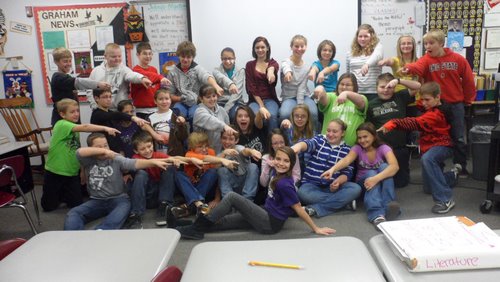
Matthew Henson was born August 8, 1866. Matthew had a rough experience in life early on...his mother died and his father was unable to care for him. With only a sixth grade education, he began working in a restaurant. He heard stories of the ocean and places unknown from the sailors who would frequent the restaurant. At age 14, he set off to find a ship! Matthew proved himself and learned much aboard the ships he worked on. He accompanied Robert Peary on his trips into the Arctic and was very helpful in forming relationships with local Eskimos on the journeys. He was a life-long learner with a passion for adventure!
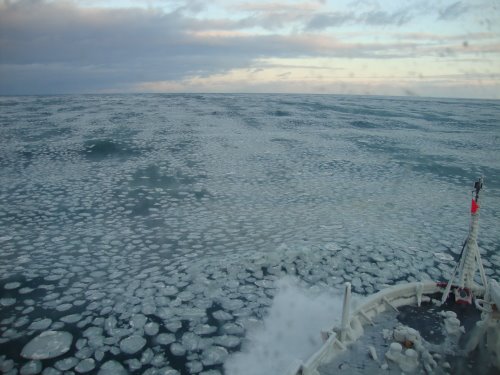
Speaking of adventure...we ARE IN ICE!! The Healy has reached first year sea ice. For sea ice to form, the top of the water column must be cooled to around -1.5C or 29F. It need to be less than the freezing point of water (0 C or 32F) due to the salt content of sea water. Ice crystals begin to form on the surface and become more numerous. This layer of crystals is called frazil or grease ice. As the freezing continues into a continuous sheet it's still transparent and it's know as nilas. Over time, the sheet of nilas will begin to clump together and form flat, round paces of ice knows as pancake ice. Pancake ice has a grey/white appearance. In dynamic areas, like the ocean where things are moving around, these paces will jostle together and form ridges around their edges and begin to look like lily pads. The pancake ice will continue to grow as new paces form and are rafted onto each other. Eventually the ice grows to the point that the sea is totally covered forming "pack ice". Thank you Chad from the National Sea Ice Center for this explanation!
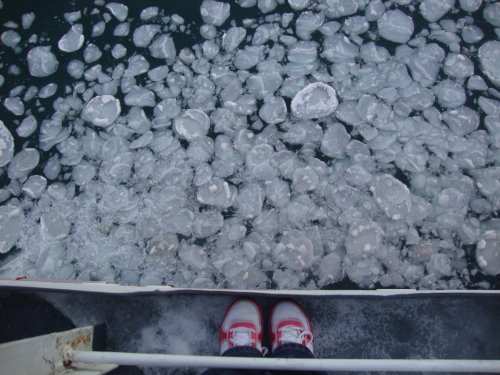
Today we deployed a mooring for Pacific Marine Environmental Laboratory (PMEL), part of National Oceanographic and Atmospheric Administration (NOAA). The mooring had been secured in the Hangar which is two decks above the fantail deck where we do science operations. The aft crane was used to lower the mooring down to the fantail.
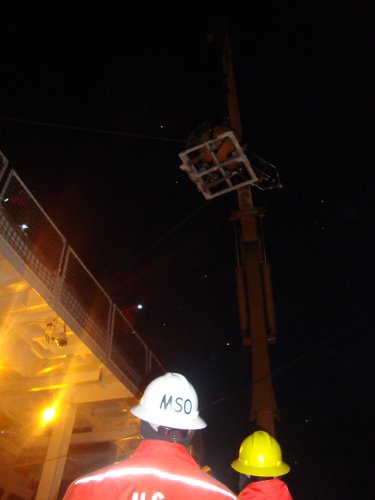
Dr. Okkonen and David Leech prepared the mooring for deployment. The mooring will be positioned on the ocean floor – about 45 meters below the surface- and will collect data including water temperature, salinity and acoustic records. Scientists will return this summer to retrieve the mooring and it's saved data.
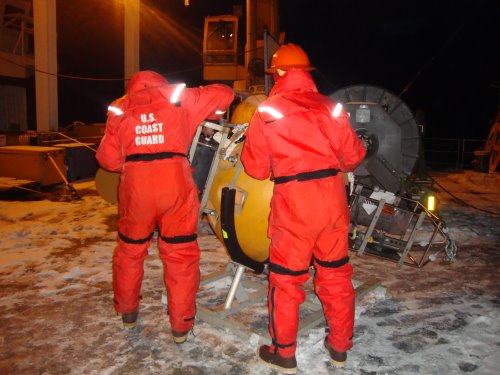
We had a special treat today for lunch...CRAB LEGS! Soon, I will post a journal about the galley – it is amazing the quality of food they can prepare for 120 people! The crab legs were no exception – TASTY!
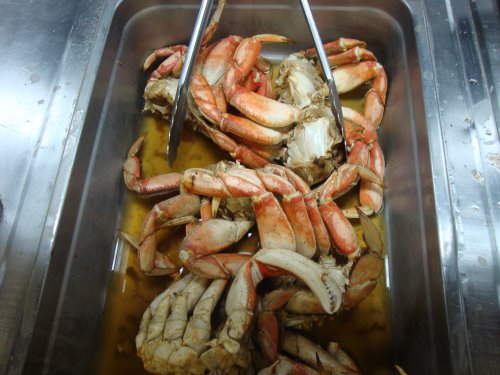
New Vocabulary:
Frazil: – small pieces of ice that form in water turbulent enough to prevent the formation of a sheet of ice
Nilas: – a thin elastic crust of grey colored ice that forms on a calm sea
Dynamic: – concerned with energy or forces that cause motion
Pack iceLarge pieces of floating ice driven together into a nearly continuous mass.: – an area of sea ice composed of a heterogeneous mixture of ice of varying ages and sizes
MooringAn anchor or weight attached to the sea floor used to hold a scientific instrument in place.: – a permanent anchor dropped in the water and equipped with a floating buoy
Question of the Day
Summarize the steps in the formation of sea ice.
Stay tuned as we continue our exciting voyage on the USCG Cutter Healy! Until then...
“Live as if you were to die tomorrow. Learn as if you were to live forever.” - Mohandas Gandhi


Comments